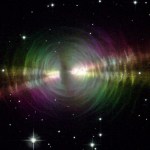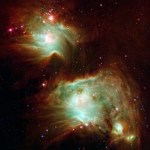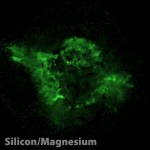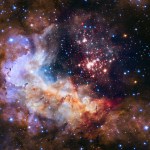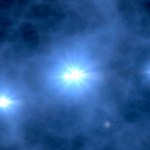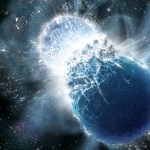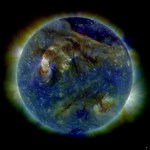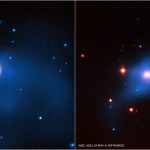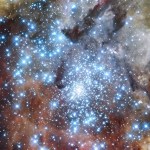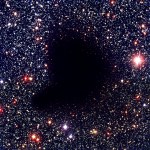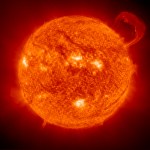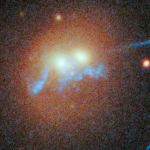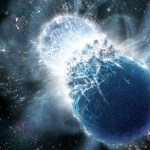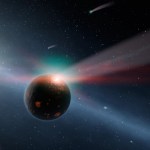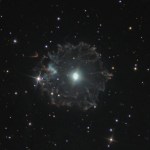Stars
“Man loves company — even if it is only that of a small burning candle.” -Georg C. Lichtenberg
The Sun, like all stars initially, burns hydrogen fuel into helium through the process of nuclear fusion. But as the Sun ages, as do all stars over a certain mass, it starts burning those heavier elements in its core, going through different phases of its life cycle and eventually ending in a planetary nebula/white dwarf combination.
Image credit: NASA, W. Sparks (STScI) and R. Sahai (JPL).
But are these transitions sharp or gradual, and what of even more massive stars that start burning carbon,…
“Life is a mirror and will reflect back to the thinker what he thinks into it.” -Ernest Holmes
When you've got a gas cloud in space that emits light, it's only for one of two reasons:
Either it's at high enough temperatures that its atoms are excited and it's emitting its own light as the electrons fall in energy and recombine with nuclei,
Or it's cool and neutral, and is reflecting light off of the brightest stars in its vicinity.
That latter case has a dead giveaway: it always shines blue.
Image credit: ESO/Igor Chekalin, via http://www.eso.org/public/images/eso1105a/.
But…
“For my part I know nothing with any certainty, but the sight of the stars makes me dream.” -Vincent Van Gogh
When we look out into the Universe, farther back to greater distances, we're also looking back in time, farther and farther into the past. If we could look back far enough, close enough to the Big Bang, we'd be able to see the very first stars ever formed in the Universe: stars formed from the Big Bang's leftover material itself.
Image credit: European Southern Observatory (ESO).
We'd never been able to find these before, but by looking at a starburst galaxy at extremely high…
“When it comes to atoms, language can be used only as in poetry. The poet, too, is not nearly so concerned with describing facts as with creating images.” -Niels Bohr
Shortly after the Big Bang, the first nuclear fusion reactions occurred in the Universe, filling it with hydrogen, helium, and little else. Billions of years later, huge numbers of stars have lived and died, creating copious amounts of heavy elements, running the full gamut of the periodic table.
Image credit: Theodore Gray, via http://theodoregray.com/periodictable/Posters/index.posters.html.
After all this time, hydrogen is…
“The wonder is, not that the field of the stars is so vast, but that man has measured it.” -Anatole France
Wherever large, dense collections of cool gas gather together under the force of their own gravity, new stars are bound to form. Every galaxy goes through peaks and lulls in star formation, yet at any given time, one star cluster will always be the largest and most massive.
Image credit: NASA, ESA, the Hubble Heritage Team (STScI/AURA), A. Nota (ESA/STScI), and the Westerlund 2 Science Team.
Discovered only in the 1960s due to its location in the galactic plane, Westerlund 2 holds…
“[I]f there were no light in the universe and therefore no creatures with eyes, we should never know it was dark. Dark would be without meaning.” -C.S. Lewis
The Universe had two periods where light was abundant, separated by the cosmic dark ages. The first came at the moment of the hot Big Bang, as the Universe was flooded with, among the matter, antimatter and everything else imaginable, a sea of high-energy photons, including a large amount of visible light. As the Universe expanded and cooled, eventually the cosmic microwave background was emitted, leaving behind the barely visible,…
“A single tiny light creates a space where darkness cannot exist. The light vanquishes the darkness. Try as it might, the darkness cannot conquer the light.” -Donald L. Hicks
While it might seem like there are an endless supply of stars in the Universe, the process that powers each and every one requires fuel to burn. At some point -- even though it's far in the future -- that fuel will all be spent, and all we'll be left with are stellar corpses of various types.
Image credit: E. Siegel.
But the Universe is full of second chances, and opportunities to bring not only burned-out stars back…
Over at Starts With A Bang, Jillian Scudder of Astroquizzical takes on a doozy of a question:
If a photon of light escapes from a star, when it hits another star, does it get absorbed and have to complete another cycle before it can escape again?
After all, it takes (on average) over 100,000 years for a photon created in a star's core to find its way to the surface and exit.
Image credit: NASA/Jenny Mottar.
But what about the photons -- much lower energy than the gamma rays the core generates -- that hit the surface? Will they simply be absorbed and re-emitted outward, the way the Earth's…
“It is by going down into the abyss that we recover the treasures of life. Where you stumble, there lies your treasure.” -Joseph Campbell
When we look at the centers of galaxies, it's no surprise that there are large black holes there, millions or even billions of times the mass of the Sun.
Image credit: Chandra X-ray Observatory (blue), Hubble Space Telescope (green), Spitzer Space Telescope (pink), & GALEX (purple).
As we look farther and farther away, and hence farther back in time, we'd expect these masses to be much smaller. But what we find is that we have supermassive black…
“The flame that burns twice as bright burns half as long.” -Lao Tzu
With hundreds of billions of stars in the Milky Way, you'd think the largest star we've ever discovered would be in the most intense star-forming regions here, perhaps towards the galactic center. It's a good thought, as we've discovered stars up to 175 solar masses there, but it's wrong.
Image credit: NASA, ESA, ESO, D. Lennon and E. Sabbi (ESA/STScI), J. Anderson, S. E. de Mink, R. van der Marel, T. Sohn, and N. Walborn (STScI), N. Bastian (Excellence Cluster, Munich), L. Bedin (INAF, Padua), E. Bressert (ESO), P.…
“The sun is a miasma
Of incandescent plasma
The sun’s not simply made out of gas
No, no, no
The sun is a quagmire
It’s not made of fire
Forget what you’ve been told in the past” -They Might Be Giants
It's such a simple fact -- that the Sun is made out of hydrogen that fuses into helium, releasing energy by E=mc^2 -- that it's easy to forget that a century ago, we knew none of these things.
Image credit: ESA and NASA,Acknowledgment: E. Olszewski (University of Arizona).
Not that nuclear fusion was a thing, not that the Sun got its energy from E=mc^2, and not even that the Sun was made…
“Dwell on the beauty of life. Watch the stars, and see yourself running with them.” -Marcus Aurelius
Let there be light! You'd think that would be enough: that you form stars in the Universe, you see those stars in the Universe, and that tells you about what's out there.
If only it were that simple.
Image credit: ESO, via http://www.eso.org/public/images/eso0102a/.
In order to truly see the first stars, you need a lot more that just starlight: you need that light to be able to freely travel through space. And -- as bad luck would have it -- visible light, the kind of light we've…
“Try to imagine what it will be like to go to sleep and never wake up… now try to imagine what it was like to wake up having never gone to sleep.” -Alan Watts
Neutron star matter is the stuff of legends: it's the densest three-dimensional material to exist in our Universe. With a density some 10^22 times that of water, you might think that a tiny chunk of it would be incredible to possess.
Image credit: The Mighty Thor / Marvel Comics.
But would such a chunk be stable, or would something catastrophic happen if you took a dense group of neutrons out of a neutron star? And if a small amount…
“As a boy I believed I could make myself invisible. I’m not sure that I ever could, but I certainly had the ability to pass unnoticed.” -Terence Stamp
When you take a look at the stars visible in the night sky, you're only seeing a tiny fraction of what's actually present in our galaxy. Your intuition would tell you that you're probably seeing the closest stars to Earth, but that's only partially right.
Image credit: Richard Powell of http://www.atlasoftheuniverse.com/.
Of the ten closest star systems in the night sky, only two of them are visible to the naked eye, and if we start to…
“Every time we get slapped down, we can say, ‘Thank you, Mother Nature,’ because it means we’re about to learn something important.” -John Bahcall
And what's possibly more important than learning how the Sun works? For nearly all of human history -- well into the 20th century -- we really didn't know.
Image credit: NASA, ESA, and G. Bacon (STScI).
Could it have been combustion, like we see on Earth? Or perhaps gravitational contraction, like that which powers white dwarf stars?
No, it turned out to be nuclear fusion. Yet when we built our best models and went to test what we expected to…
“Look and think before opening the shutter. The heart and mind are the true lens of the camera.” -Yousuf Karsh
When you find an incredibly huge, dense collection of mass, all together in one place, it generally indicates a galaxy cluster of tremendous size.
Image credit: NASA, ESA, G. Tremblay (ESO), M. Gladders and M. Florian (University of Chicago), S. Baum, C. O’Dea, K. Cooke (RIT), M. Bayliss (Harvard-Smithsonian Center for Astrophysics), H. Dahle (University of Oslo), T. Davis (ESO), J. Rigby (NASA/GSFC), K. Sharon (University of Michigan), E. Soto (Catholic University of America), and…
“End? No, the journey doesn’t end here. Death is just another path, one that we all must take. The grey rain-curtain of this world rolls back, and all turns to silver glass, and then you see it.” -J.R.R. Tolkien
No matter how well we care for our bodies, they eventually wear down, give out, and we all will someday face death. Yet if there's anything to be learned from looking at the physical Universe, there's no reason to expect that death is truly the end.
Image credit: NASA/ISS Expedition 28.
Every time a star runs out of fuel and dies, no matter what type of star it is or what fate…
One of the great, catastrophic truths of the Universe is that everything has an expiration date. And this includes every single point of light in the entire sky.
Image credit: Rogelio Bernal Andreo of Deep Sky Colors, via http://deepskycolors.com/astro/JPEG/RBA_Orion_HeadToToes.jpg.
The most massive stars -- like Betelgeuse (at the upper left) -- will die in a spectacular supernova explosion when their final stage of core fuel runs out. At only an estimated 600 light years distant, Betelgeuse is one (along with Antares) of the closest red supergiants to us, and it's estimated to have…
“From an incandescent mass we have originated, and into a frozen mass we shall turn. Merciless is the law of nature, and rapidly and irresistibly we are drawn to our doom.” -Nikola Tesla
Stability: it's the hallmark of the Solar System. The motions of all the planetary bodies are regular and periodic. The paths of the various objects never cross, and everything that has continued for billions of years should continue, undisturbed, for billions more.
Image credit: Mark Garlick / Science Photo Library.
Unless, of course, something came along to mess that up! In our Solar System, the comets…
“I lie on the floor, washed by nothing and hanging on. I cry at night. I am afraid of hearing voices, or a voice. I have come to the edge, of the land. I could get pushed over.” -Margaret Atwood
We had a great run with Messier Monday, followed by a fun mini-series on Mini-Movie Monday, but now it's time to shake things up.
Image credit: Nordic Optical Telescope and Romano Corradi (Isaac Newton Group of Telescopes, Spain), via http://www.spacetelescope.org/images/heic0414b/.
Starting today, I present to you a new, ongoing series: Mostly Mute Monday. The rules are as follows:
I pick one…
